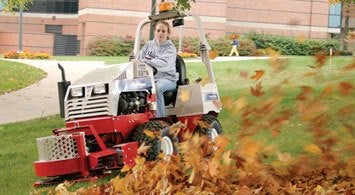
It’s that time of year again. Foliage is peaking in the North but just showing signs of color to the South. And in some locales annual leaf cleanup has already begun. No matter where you are, leaf collection and removal go hand in hand with seasonal change. How to best handle it, though, can be a combination of personal preference, size of property, equipment at your disposal, and the amount of time available to devote to it.
As winter settles in, there is not enough light or water for photosynthesis, the process of converting carbon dioxide into oxygen and sugar, to occur. Trees shut down their chlorophyll making process (what gives plants their green color) and they begin to shed their leaves. And while those vivid yellows and reds are at first vistas of visual beauty, the leaves soon turn drab and soggy and few choose to allow the decomposing material to remain on their lawns and gardens through the winter.
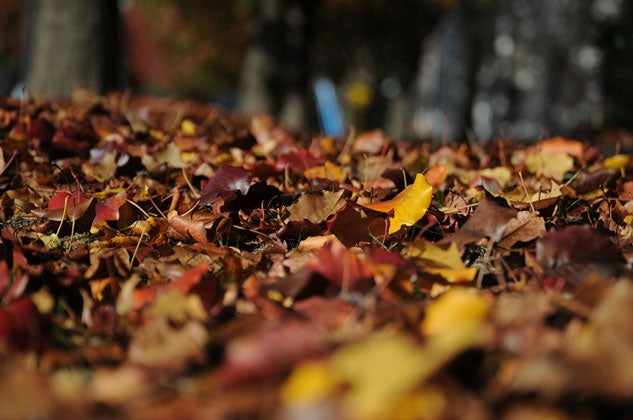
One of the oldest and most effective methods of collecting leaves is the rake. And for small areas it is usually the first choice. Rakes come in a variety of configurations using a variety of different materials. Our choice for leaf raking would he a rigid poly rake with a cushioned handle that helps minimize blisters on hands. Good working widths are typically 30” to 36”. We’ve even seen rakes as wide as 48” but those are often too cumbersome to get between shrubs and flower beds. As effective as a rake can be, it still only gets leaves to a central place – the pile – where additional handling is required.
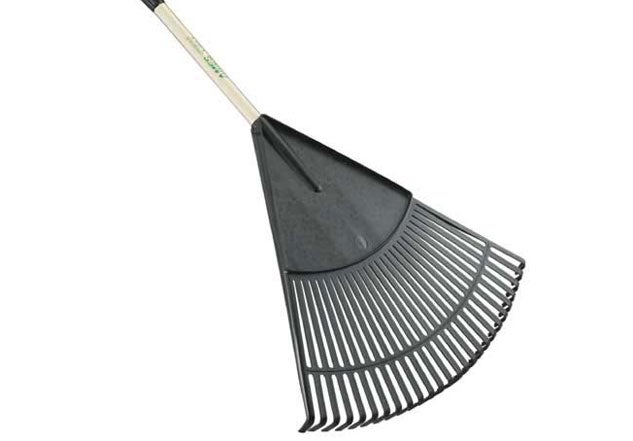
Today the high winding pitch of leaf blowers seems to be synonymous with fall. Leaf blowers can come in electric, two-cycle, four-cycle and even tractor driven power take off (PTO) forms. Leaf blowers can be hand held, backpack carried, pushed, pulled or even mounted to rigid platforms. All are confronted with the same dilemma as the manual rake: once the central pile is created, a second handling to some other location is required.
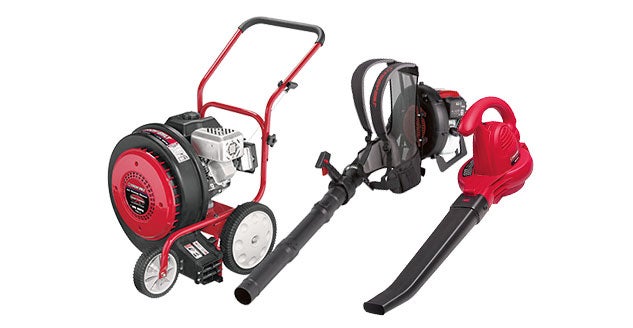
The number of ingenious methods of moving those piles is many, but a few of our favorites are the simplest. Tarps are great for this task. Just rake or blow the leaves onto the tarp, fold up the corners, and drag everything to the desired destination. Tie a couple of ropes to the tarp grommets and make things even easier by attaching the other end to a tractor or UTV/ATV. Another variant is a wire mesh or plastic mesh sheet which can work equally as well. In some instances, we’ve heard of the sheets being applied well before the leaves fall. Grass continues to grow between the mesh which remains mostly hidden until the leaves come down. Then, with a little tugging, the mesh can be pulled up and folded over the pile with everything ready to be moved to the desired location.
Collection systems that attach to a tractor or z-trak are another popular method of handling leaves and can be as simple as the grass collection system already in place or units that require a second power source. One advantage of these types of systems is that they shred and compact the leaves, which then take up less space. A disadvantage with some systems during damp to wet conditions which often go along with fall collection time is that they may frequently clog. Systems with a second source of power generally fare better.
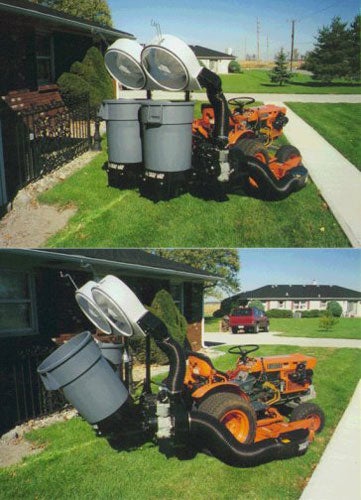 |
Sweepers are another method of collecting leaves. They work well, even picking up twigs, acorns, and grass thatch and clippings. And there is nothing like that fresh clean and swept look afterwards. The problem is the hopper, generally constructed of fabric/plastic, fills up quickly. This can mean many trips to the unloading location. Generally these units are pull-behind designs, though front mounted, PTO driven brooms are available.
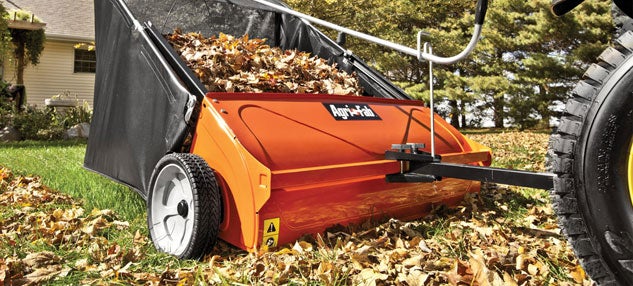
Tow behind vacuum systems are another method of leaf collection that is highly effective. These systems rely on a cart that can range in capacity from a couple of 44-gallon Rubbermaid containers to carts holding 13+ cubic yards of material. Powered by separate engines ranging from 6 hp to 16 hp+, these systems can include a chipper able to handle limbs up to 3” in diameter or more and extension hoses to reach those tight areas.
Finally, you can just mulch. Studies by Michigan State University suggest mulching leaves into dime-sized pieces, through the use of aggressive blades and/or multiple passes, is a simple and effective way to go. Once the leaves settle in over the winter, microbes and worms will get to work recycling. In the spring the leaf litter will be gone and those organic materials will have beneficially gone into your soil. Those choosing to adopt this method often find this a good time to plug aerate, overseed, and get that fall fertilizer down.
Rakes
Cost: Under $10 to $20+
Pros: Inexpensive, durable, low maintenance.
Cons: Can be a lot of effort, especially for large areas.
Leaf Blowers
Cost: $40 to $500+
Pros: Effective, lowered effort, some units can chop/chip.
Cons: Noisy, some require mixed fuel, will require maintenance.
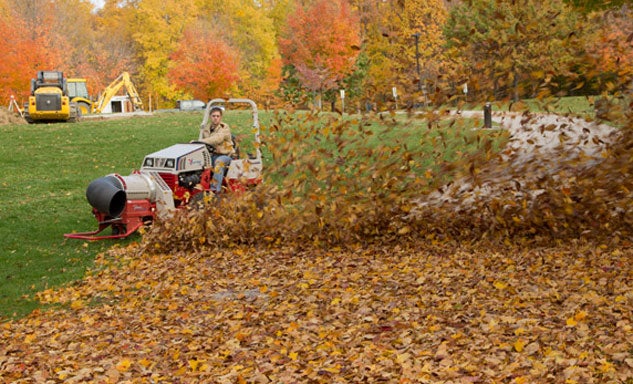
Tarps
Cost: Under $10 to $25+
Pros: Effective method of collecting and moving leaves.
Cons: Can easily wear out from use.
Bagger Systems
Cost: $100 to $500+
Pros: Same system that collects grass clippings can collect leaves.
Cons: Can clog up with wet/damp leaves, can require many trips to dump location.
Sweepers
Cost: $100 on sale to $500+
Pros: Sweep that lawn clean while picking up twigs, acorns and grass thatch/clippings.
Cons: Need to frequently be dumped, less effective when wet.
Tow Behind Vac Systems
Cost: $1000 to $3000+
Pros: Work very well, may offer limb chipping ability, some have extension hoses.
Cons: Expensive, large to park/store, will require maintenance.
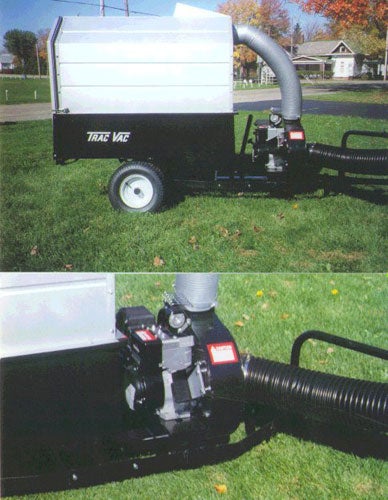 |
Mulching
Cost: Zero with existing equipment to $13 ea. for GatorBlades.
Pros: Work well, put that organic material into your soil.
Cons: May require multiple passes, messy when wet.
So which method is best for you? At Tractor.com our contributors have experimented with most every combination. The consensus? There is none. Some prefer that perfect manicured look and opt to mechanically haul those leaves away, others like the “green” approach of using a rake. Yours truly has been mulching for the last several years and has been pleased with the results.

 Your Privacy Choices
Your Privacy Choices